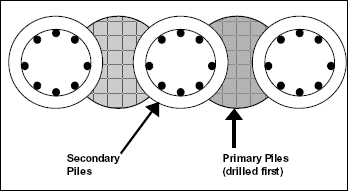There are many ways to construct a large diameter shafts such as is being built for the ECT project. Some of the methods are liner plates, ground freezing, jet grouting, diaphragm wall, sheet piles, solider piles and lagging and sinking caisson ( I could go on but there is no need to bore all of you). The secant pile method was chosen for a variety of reasons including the applicability to the ground conditions at the site and economics, site/job restrictions (time, amount of space at the site, proximity to residents and business).
This is an explanation of a secant pile from a general construction book:
Secant piles are constructed so that there is an intersection of one pile with another. The usual practice is to construct alternative piles along the line of the wall leaving a clear space of a little under the diameter of the required intermediate piles. The exact spacing is determined by the construction tolerances which can be achieved.
Concrete is added and the intermediate holes are drilled along a parallel, but slightly offset, line so that the holes cut into the first piles. The intermediate piles are placed through a heavy casing whose cutting edge is toothed and enables the casing to cut into the concrete of the initial piles on either side. Subsequent concreting results in a continuous wall. The concrete chosen will often have a slow rate of setting in order to ease the problem of cutting one pile into another.
Another way to look at a secant pile wall/shaft how they are being built for ECT, in general:
Drill a hole in the ground 4' in diameter that is 100' deep. This hole will be lined at all times with casing (steel pipe) and the soil/rock will be removed with an auger (think really big drill bit). Once the final depth is reached, fill up the inside of the casing with concrete and pull out the casing. You are now left with a column of concrete that is 100' deep and 4' in diameter surrounded by soils.
Now move over so the center of the new hole being drilled is about 5' away from the previously drilled hole and repeat the process above. This will leave 2 columns of concrete 100' deep 4' in diameter that are about 1' apart at their outside edges. This process will be repeated 16 times. At this point all that we have is 16 individual columns of concrete (piles) that are 100' deep and 4' in diameter that are all surrounded by soil and acting as 16 individual columns.
Now the cool things begin to happen. A new pile is drilled in between the already installed piles and a portion of the original (primary) piles is removed. The primary piles look like what is left over when you eat an apple, skinny in the middle and wider at the top and bottom. So we now have a secondary pile drilled between two primary piles. Once again the casing is filled with concrete and the casing is removed but in these secondary piles a steel reinforcing cage is lowered in place in the fluid concrete prior to the concrete hardening. We now have a series of three secant piles and 15 other piles still just siting out there not doing much. The pile installation will continue until all primary piles have secondary pile installed adjacent to them and a continuous wall has been formed for a depth of 100'.
Once all the individual piles have been installed and acting together we have a system that will protect our contractor as they work inside the shaft digging out the soil and rock getting down to the level of the tunnel. There is a little more that goes into the design of the shaft like an evaluation of hoops stresses, effective earth pressure and other engineering geek talk.
